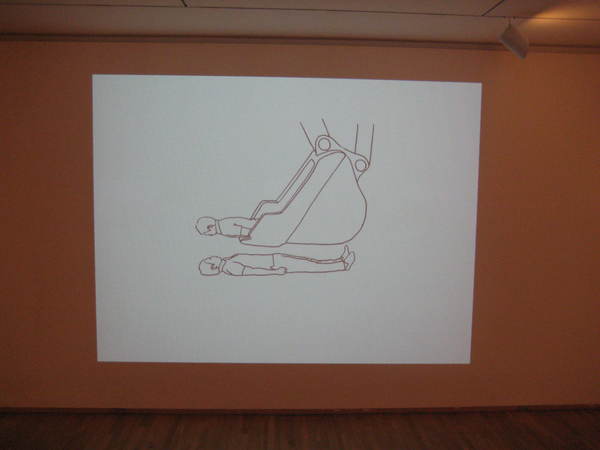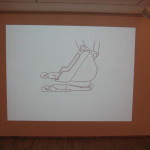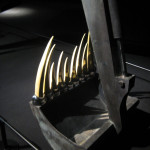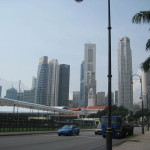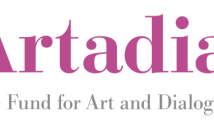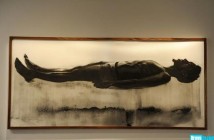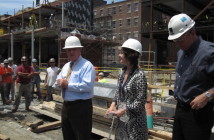So I have been back in the U.S. for a couple of weeks now, hoping to find time to process and really think about my journey. But as we all know, life goes on. And if your life is as crazy as mine is in terms of commitments you will understand that finding the time to sit and reflect is pretty impossible. So forgive me if this article rambles and stumbles from concept to concept. I’m hoping that events and ideas and memories become clearer as I write. This might not prove to be true but I’m going to give it a try.
It seems oddly appropriate that President Obama is currently jaunting across Asia in roughly the same pattern that I took (only backwards – he is going from Singapore to Beijing to Seoul). I chose these three cities as they seemed representative of the forward movements in the contemporary art world. Presumably the President has chosen these for strategic and economic purposes. I guess that is one way to begin thinking about the three very different spaces. All three cities seemed to ring with a vibrancy I am hard pressed to find in a U.S. equivalent. While some who ran artist spaces spoke of the economic downturn in South Korea the city and the people themselves seemed to be exploding with energy in every direction. There was construction and mass amounts of shopping and a feeling that anything was possible. This feeling reverberated across every region I visited. Beijing was a beast of power and dynamism. And Singapore felt the same. There was optimism and enthusiasm everywhere I turned. The mood was a far cry from what I witness in America. But alongside such ardor for change and the future there was intense skepticism. And it was manifesting itself in the art I came across.
Construction and change are constants in Asia today. Each city I visited displayed a vista of cranes in constant motion. And while I anticipated this, to see it in person is really stunning. Especially in light of our own blighted Downtown Crossing where I daily walk past the half demolished Filene’s Department Store building (swaying cranes are a rare site in any American city right about now). Everywhere I turned there was a building under construction if not several. And what I found interesting is that this aspect of daily life was manifesting itself in the art. In each city I came across an artist who was working with cranes, if not construction imagery.
In Seoul, I stumbled upon the Kumhomuseum. They were showing the work of Jeong Ki Hoon in an exhibition titled “How to Use an Excavator.” The show involved animation, some photographs and a small sculpture, all of which involved the artist in some way interacting with an excavator. As the artist says in the program, “The excavator is a common equipment in heavy construction machineries…it gives me awe to look at the equipment’s massive movement with its shovel digging away everything around it. It relates to the human desire to perpetually develop and find practical uses. A building that has long held memory is completely torn down even before it is restored and changed with its new environment.” For the artist this piece of equipment represents the power of change and the human desire to renew and rebuild. Not such an odd perspective given the history of South Korea and specifically Seoul. This is a city that has been invaded and occupied numerous times in the twentieth century alone. Much of the city was destroyed during World War II and the Korean War. It literally changed hands several times (between the North and the South) over the course of a decade. There is very little architecture that survived. As a result much of the city has been constructed very recently. There are old parts of the city that remain. Many of Seoul’s art galleries occupy these neighborhoods – specifically around the Insadong and Gwanghwamun districts. But the majority of this extremely large city has an almost futuristic feeling. Everything is a high rise and the towers go on and on forever. At first, this was interesting, but after the first twenty or thirty of them I quickly realized they were ubiquitous. The main point: Construction is everywhere and, off course it is going to have an effect on artists and the art they make.
Another artist I came across who was also commenting on the extreme cultural and environmental changes in Asia. A Chinese artist by the name of Lu Hao. had an exhibition at the Singapore Art Museum entitled “Cities Here and Now.” The show was predominantly paintings (large scale acrylic paintings of products on store shelves – pretty cool looking actually) with several sculptures. The largest sculpture, “Tool of Construction," 2005, consisted of an excavator made of bronze and steel with large, shark-like teeth attached to the scooping end of the device. Lu Hao’s piece goes one step further than Jeong’s in that he has built a constructing device. But while the latter’s work had a degree of whimsy and humor about it, Lu Hao’s leaves one disconcerted. The sharp teeth of the device resist any attempt to think of it for its beneficial purposes. Lu Hao's tool rips and shreds (which it honestly does). There is no space for sentimentalizing or fondness. For Lu Hao, the excavator is a destroyer. And this is far more indicative of the role of construction in China. In Beijing, whole neighborhoods were destroyed and replaced in order to create dazzling contemporary spaces for the Olympics. Neighborhoods, known as Hutongs, that had been around for centuries were razed and those that couldn’t be completed in time were simply covered up with walls. There are sections of Beijing where a giant façade would stand in place of a street front. Behind the three-story wall covered with advertisements for Rolexes and Fendi bags were gaping holes where an urban village once stood. The politics of construction and excavation were decidedly different from that I witnessed in Seoul.
And Lastly, my third interaction with the effects of the construction boom took place during critiques of student work at the Nanyang Academy of Fine Art in Singapore. This is where I actually got to talk to art students, who’s work was directly commenting on changes taking place in their city. Two students, one a diploma and the other a grad student, were specifically talking about how urban changed affected them personally. The first student, Jason Lee, was in the early stages of a photography project that involved him shooting a construction site near his house every day. The project was still very broad and he needed to really think about why he was doing this and how to better approach the subject. But, it was fascinating to hear him talk about how this construction was changing the face of his neighborhood and how powerless the people in his community were to stopping change. The other student’s project was much farther along. Regina De Rozario was doing a performance and photo project on a former cemetery in Singapore. In 2003 the Singapore government decided to move the Bidadari Cemetery. The cemetery had functioned from 1908 to 1972. The government wanted to redevelop the land and so set out to exhume and cremate the people buried there and pass them along to the next of kin. The government set up a research arm to find and contact any surviving family members and began exhuming. De Rozario’s grandfather was exhumed and returned to her family. The cemetery currently sits vacant and undeveloped. There was a metro stop built near the site that has never been opened. What had planned to become a vibrant community is now an empty field. De Rozario began thinking of ways to map out and remind residents of what used to be there. As their city looks constantly forward, the memory of what urban spaces were and how they were used disappears. I think what I found fascinating is that these students were questioning development in an environment where everyone around them thinks that this is the greatest moment ever. They were struggling with the very real effects of never ending urban change. They really didn’t know what to do about it.
And this was one of the more startling aspects of expansion. There is no way to stop it. These three countries are moving forward. Their cultures (not to mention their economies) are no longer tied to some historical moment or some past that involved European powers. They reveled in their histories, to be sure, yet it seemed to me that this only validated their decision to look forward. This was probably most evident in China (not surprising considering the multiple millennia of culture one can mine there) but was also prevalent in Singapore, a city that really didn’t exist as such prior to the 18th century. To witness the art and culture of these three cities was to see time moving past at breakneck speed. Our conversations in Beijing often centered on the fact that China has leapt from the 19th century to the 21st in a couple of decades. What does that do to one’s psyche? And how does that manifest in a country’s art?
- Jeong Ki Hoon, How to Use An Excavator, Animation, 2009. – See more at: http://www.bigredandshiny.com/cgi-bin/BRS.cgi?section=article&issue=119&article=20091015104449574131303819#sthash.PYNaYVDt.dpuf
- Lu Hao, Tool of Construction, Bronze, Steel, and Rosin, 2005.
- Look across the cricket grounds to the Financial District, Singapore.
"How to use an excavator" was on view until October 18th, 2009 at Kumhomuseum, Seoul, South Korea. All images are courtesy of the artist and Kumhomuseum.
"Cities Here & Now" was on view until October 25th, 2009 at Singapore Art Museum, Singapore. All images are courtesy of the artist and Singapore Art Museum.

